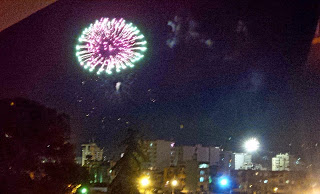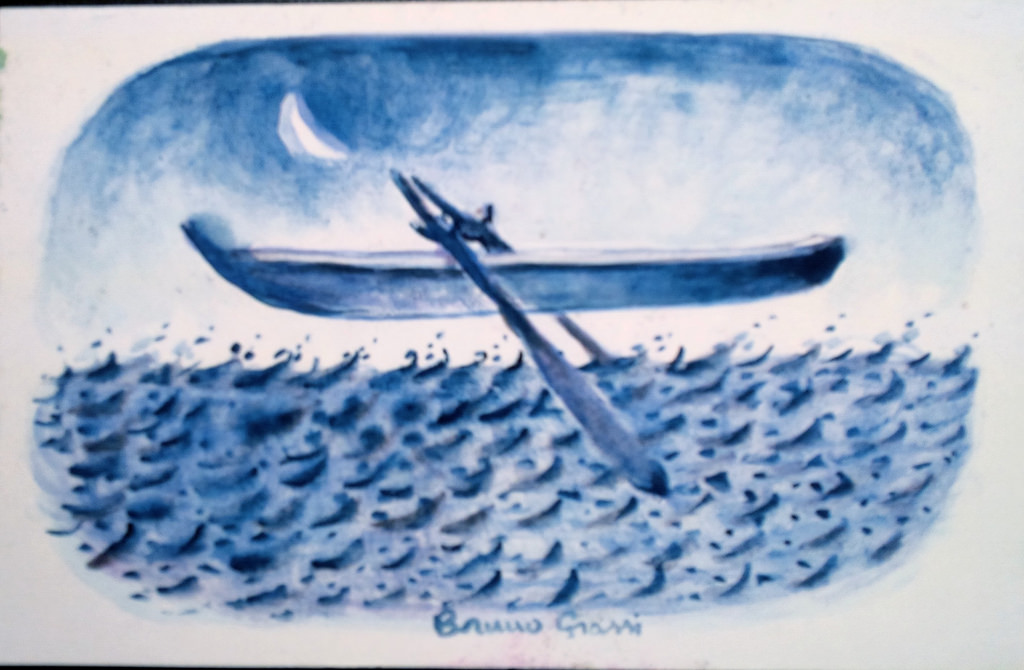I had decided to sleep in Tuesday morning in Bari since, apart from visiting St. Nicholas and buying a ticket for the ferry to Durrës, I had nothing planned. I was awake, although lounging in bed, when I heard the first of the very strenuous (and loud) rattlings of a nearby door. It was loud enough, and went on long enough, that I finally pulled on my clothes and went to investigate.
My fellow guest from the night before had managed to lock herself out of her room, and the hostel was currently unstaffed. I tried to help her, with no success. (I don’t like those skeleton keys, and usually just leave my room unlocked. The poor man laughs at thieves.) She roused another guest, who was similarly unsuccessful. I tried to find a contact phone number that we could call, to no avail. At this point, the poor woman broke down and started sobbing quietly, but with great force. The other guest re-emerged from his room, and this time managed to unlock the door. The sobbing continued for several minutes, but at least she was back in the privacy of her own room. I finished my breakfast and packed quickly. As I left my room, I saw that my neighbour was seated at the table eating breakfast. I caught her attention and wished her “Auguri.”
It was a bright clear morning, and I walked briskly down the broad sidewalk towards the old part of Bari which I’d inadvertently explored the evening before. The hostel where I’d spent the night included “breakfast” but didn’t provide any form of caffeine. Highly irregular, especially in Italy! I was caffeinated a few short moments after leaving the hostel behind.
It was a few minutes past 9:00 when I entered the Basilica of San Nicholas in Bari for the first time. This large church was built in the 11th century to house the relics of St Nicholas of Myra (in Lycia – modern day Turkey) which were stolen from the cathedral there by 62 sailors from Venice. They made landfall in Bari, and I’m sure their names are recorded somewhere. (“Thief! Baggins! We hates him!”) As I entered, I noted the sign requesting silence posted on the doors was printed in three languages: Italian, English, and Russian.
I won’t bother with a description of the church. It was impressively big, with some 15th century arches spanning the nave to provide support for the walls, and there were some very nice 14th century icons, but none of that was why I had chosen to come to Bari instead of leaving Italy from Brindisi. I had come to venerate the relics of St. Nicholas.
Coming from the crypt, I could hear the sounds of the assembled faithful at prayer, so I decided to look around the church until Mass was over. Once people began coming up from the crypt and entering the nave, I headed down.
My timing couldn’t have been better. The altar area in the crypt is surrounded by an impressive iron cage, but the gate in front of the altar table containing the relics of the saint was open, and people were approaching to venerate the tomb. I gratefully got in line. All the relics in Rome were safely locked away from pilgrims, tourists, and would-be thieves, so this was a unique opportunity for me.
A similar gift was given to me in Santiago de Compostela in 2010. My last day in the city, I’d walked the few kilometres to the cathedral from my hostel with my backpack and walking stick, and headed down to the crypt to say a final farewell. It was early enough in the morning that I knew there would be no crowds, so I was very surprised to discover I’d blundered into the midst of a Mass being celebrated on the crypt altar. As silently as I could, I placed my pack on the floor, and remained kneeling outside the sanctuary. (There were only half a dozen people inside, plus the priest.) When the Mass concluded, everyone present venerated the relics, and I was invited to do likewise. Then the gates were locked up against the flow of people soon to come.
Shortly after I’d had my turn with the relics of St Nicholas, the priest closed the gate, and that small window of opportunity for other pilgrims along with it. After spending a few more minutes in silence, I headed back upstairs, collected my backpack from the pew where I’d left it, and started off to the port to see about buying passage to Albania. All I knew about the schedule was that there are two companies offering passenger service from Bari to Durrës, and they each run two ferries per day during the work week. A few minutes and €79 later, I had my ticket for the 11:00 PM ferry.
With thirteen hours to kill, I sat at a café and had a coffee and foccacia. I also found WiFi, so I posted a few random thoughts to Twitter. Thus fortified, I returned to the basilica, and this time I took pictures. While sitting in the crypt, I also took the time to pray for all the Nicholases and Nicoles that I know (that scene from My Big Fat Greek Wedding, right?) and bought and lit a bunch of candles.
After leaving the church, I headed over to the sun-soaked sea shore. The old city of Bari juts into the Adriatic, with the port on the north side. I basked in the sun for a bit, and then headed back to the basilica. By this time, the sun had come around enough for me to get a decent photo of the facade. After clicking away, I wound up at a café with free WiFi, where I ate lunch and uploaded some photos.
After wandering a bit and meeting up with an Italian man I’d spoken with earlier in the basilica, I paid a whopping €3 admission to the “Castello Svebe.” The original fortifications on the site are credited to Roger II, the King of Sicily. He was the second generation of Normans to come rampaging through southern Italy, and he succeeded in conquering not only Sicily, but all of southern Italy right up to the border of the Papal States. (His heirs were not able to hold their patrimony.)
After wandering through the site, I headed to the port, checked in six hours in advance, and proceeded to wait. Boarding began at 7:30, but it was 9:00 before I got on board. Since I hadn’t paid for a cabin, I was left to find a place in one of the lounges. I wound up unfolding my sleeping met and using it for its intended purpose for the fourth time on this pilgrimage. I wish I could say that I slept well, but the lounge got very warm very quickly, and there was a very convivial and loud group of Albanians nearby who didn’t bother sleeping during the overnight passage.
Once I cleared customs, I went looking for a place to stay. I walked in a rather large circuit before arriving at a hotel about 15 minutes from the port. It was also a ten minute walk from the Cathedral of St Paul and St Astius, the Orthodox cathedral in Durrës. After checking in, I went to find out what time the Christmas Liturgy would be celebrated. (6:00 AM Christmas morning.)
I went to bed early, and was at church by 5:50 AM. By the end of the services, I was able to recognise certain key liturgical phrases. After Liturgy, I introduced myself to the head priest, and he in turn invited me to a reception in th church hall for the local politicians. After this, I headed back to the hotel, and typed up one of my overdue updates.
On December 26, I arrived at church an hour late. (I’d misunderstood the time the previous day.) Once Liturgy was over, arrangements were made for me to visit the Monastery of Shen Vlash. This was reestablished on the site of the former monastery following the collapse of Enver Hoxha’s communist regime in 1991. The monastery now hosts an orphanage and the Theological Academy of the Resurrection of Christ.
I’d arrived to see the monastery and get a blessing from the bishop (and a stamp for my pilgrimage book). I was served coffee, and then appetisers arrived. After I’d finished those and was preparing to leave, I was told, “Lunch is ready. Won’t you join us?” Albanians rightly pride themselves on their culture of hospitality.
Afterwards, I headed back to the hotel and checked in for one more night. It had started to rain heavily by this time, so I was glad of a familiar place of refuge. I ventured out to see whether the Archeological Museum was open (it wasn’t), and got dinner on my way back. I tapped out more of my Rome update, and got an early night.
My summary for December 27 adequately covers the next day.
I woke up today to the sound of a ferocious wind rattling the windows of my hotel room in Kavajë. I knew that the forecast called for lots of rain, but the wind was a surprise. Nevertheless, I geared up and headed out for Peqin. An hour later, I stopped for a break at a service station a few kilometres out of town. My body was warm and dry, but my knees were damp and chilled because of the strong wind and the cold rain.
The first person I greeted in the café offered to buy me a coffee. We chatted a bit in Italian, and he told me there was a hotel just a few hundred metres ahead. Since I’m no longer racing the Schengen Area visa deadline, I checked in.
After chatting with the men in the café downstairs for a bit, I headed up to my room. I surprised myself by falling asleep for an hour and a half. When I came back downstairs, I was just in time for lunch. Fresh stewed beef, two kinds of cheese, Albanian corn bread, olives, and oranges grown by the proprietor.
He owns a reception hall next door to the hotel, and invited me to come with him to a wedding reception that was ongoing. The music was loud, the spirits were high, and there was WiFi. 😉 As it was winding down, I eased out the side door and headed back to my room.
The forecast for tomorrow looks good for walking, although i’ve been invited to a party with (what I’m told) is the best live band in Albania tomorrow evening here on the outskirts of Kavajë. I’ll see how I feel in the morning.



